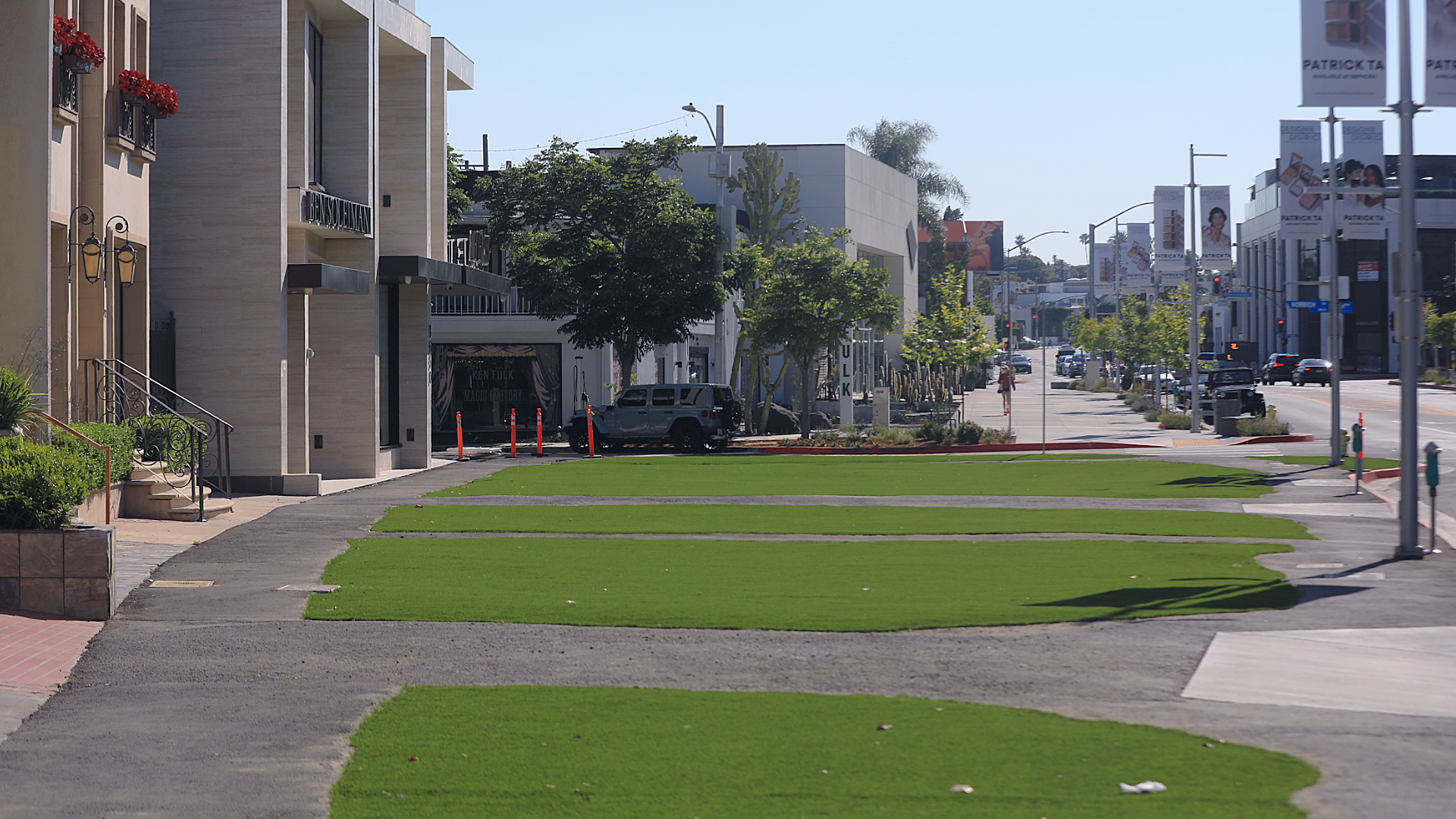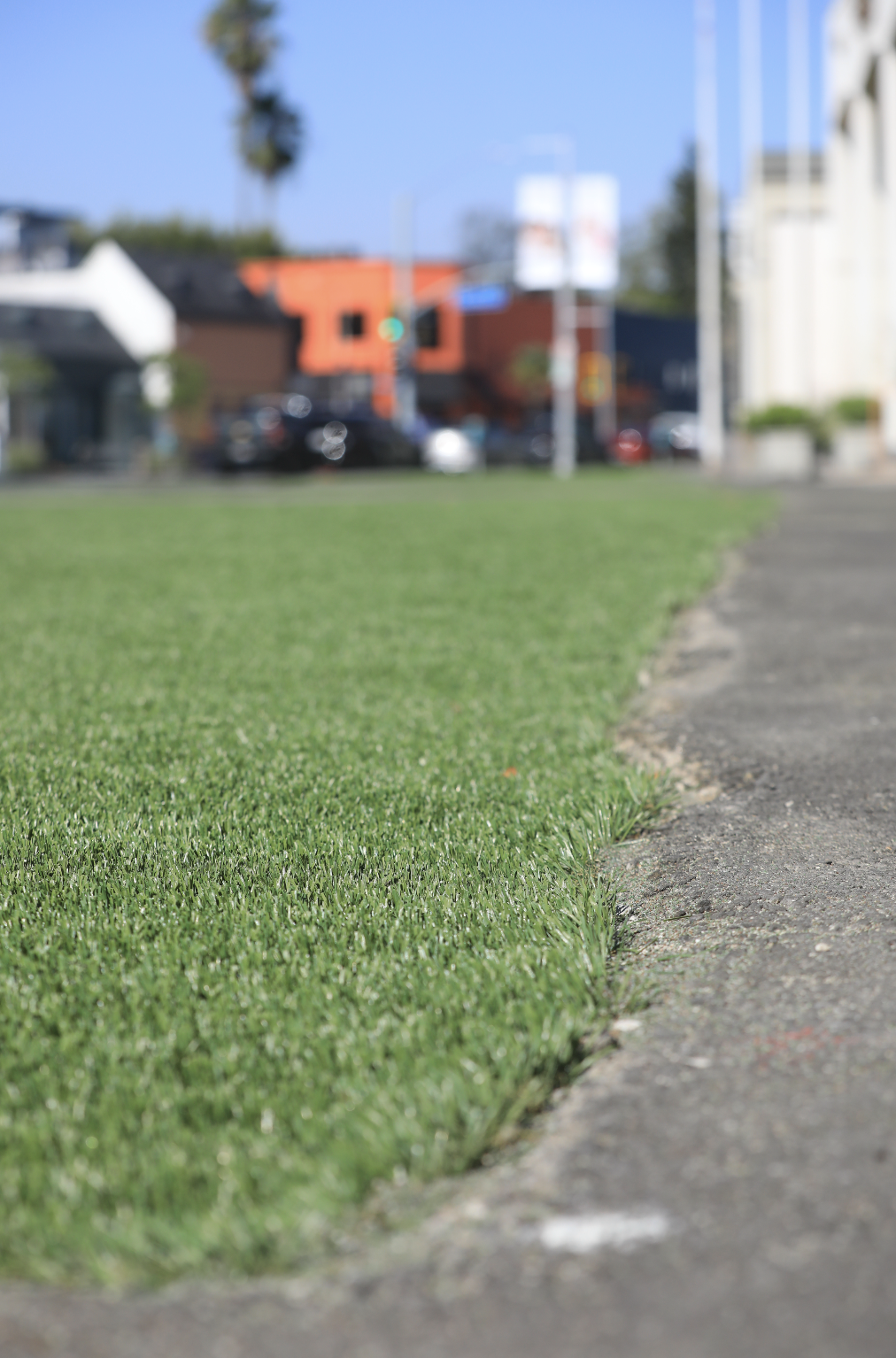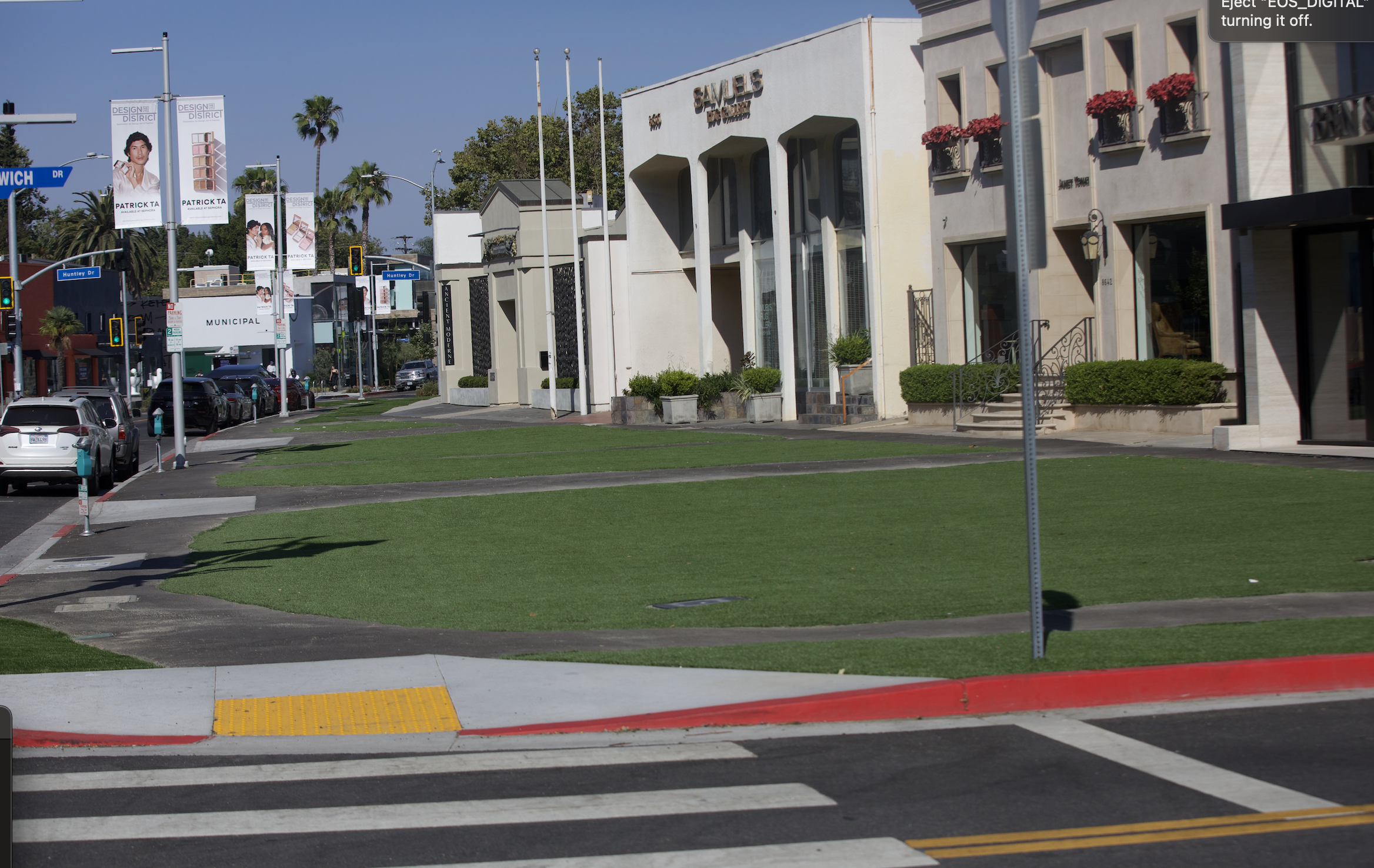
The Weaver’s Walk project has been a long-gestating initiative aimed at enhancing the pedestrian experience along Melrose Avenue. Originally designed to include 25 trees, the project was intended to provide shade and beautify the area. However, business owners, particularly Ben Soleimani, voiced concerns that the trees would block storefront visibility and signage. As the project was held up, the city covered the area with asphalt as a temporary measure for cars and pedestrians.
City Council ultimately voted to proceed with the current plans, and the temporary asphalt was replaced with temporary synthetic turf.
A related concern has arisen at William S. Hart Park, managed by the City of West Hollywood but owned by the City of Los Angeles. Planned improvements for the park include replacing the wood chips at the dog park with artificial turf, a move opposed by various community members. The Los Angeles City Council’s Energy and Environment Committee recently approved a motion to study the effects of PFAS and other “forever chemicals” found in synthetic grass, which could impact the park’s planned improvements.
SB676, signed into law this year, restored power to city and county governments to ban or regulate artificial turf in residential settings, reversing previous legislation that prohibited such bans. Cities such as San Marino and Millbrae have already enacted bans.
Artificial turf was first developed in the early 1960s by a team of researchers led by David Chaney at North Carolina State University. The material was initially intended for use in sports facilities to provide a durable, all-weather playing surface that required minimal maintenance compared to natural grass. The first major installation was at the Houston Astrodome in 1966, which gave rise to the popular term “Astroturf.” The success of this installation quickly led to the adoption of synthetic grass in other sports stadiums, particularly those with indoor or multipurpose fields.
The use of synthetic grass expanded beyond sports facilities in the late 20th century. It became popular in commercial and residential landscaping, driven by its promise of reduced water usage and maintenance costs. Cities facing drought conditions, like those in California, heavily promoted artificial turf as a water-saving measure during the early 2000s. Homeowners and businesses were incentivized with rebates to replace their natural lawns with synthetic grass, leading to widespread adoption across various urban and suburban environments.
However, recent studies and environmental concerns have cast a shadow over the benefits of synthetic grass. One of the primary issues is the presence of polyfluoroalkyl substances (PFAS) in the turf. PFAS are a group of human-made chemicals that are resistant to water, oil, and heat, making them ideal for industrial applications but problematic for the environment and human health. These chemicals have been linked to serious health problems, including cancer, liver damage, and developmental issues. The persistence of PFAS in the environment and their tendency to accumulate in living organisms have raised significant health and environmental concerns.
Moreover, synthetic grass contributes to the urban heat island effect, a phenomenon where urban areas experience significantly higher temperatures than their rural surroundings. Unlike natural grass, which helps cool the environment through evapotranspiration, artificial turf absorbs and retains heat, often reaching temperatures much higher than the surrounding air. This not only creates uncomfortable and potentially hazardous conditions for users but also exacerbates overall urban heating, increasing energy consumption and stressing local ecosystems.
In response to these growing concerns, legislative actions have begun to address the use of synthetic grass.
Environmental groups are advocating for sustainable alternatives, such as native plant landscaping, which requires minimal irrigation and supports local biodiversity.
Kelly Shannon, associate director with the Los Angeles Waterkeeper, highlighted the environmental and health concerns of artificial turf, noting its contribution to the urban heat island effect and its negative impact on biodiversity. Charles Miller, with the Climate Reality Project, advocated for replacing artificial turf with native plants to foster biodiversity and natural cooling. He pointed to the Westwood Greenway native habitat as an example of how native plants can naturally clean water and require less irrigation.



[…] much-maligned temporary synthetic turf on Melrose and Huntley came at a cost of $38,790.17. Construction management and inspection of the […]
Fake grass is already illegal on Weho parkways and front yards. It’s bizarre that fake plastic grass has been installed here.
This is just laughable about the “AstroTurf” because it adds to warming. I remember in one of the broadcast meetings I asked what material would the street be made with. The spokes guy said, blacktop. So, replacing the white concrete street, which reflects, not absorb, heat from the sun and is more durable, with blacktop is the best course. And now we are having the argument with fake grass, which has been pushed on us by the climate folks and water folks, is no BAD. Lunacy! Can’t win. AND the retailers do have a point. Don’t plant a forest in… Read more »
There’s something hypocritical about banning plastic bags and then covering the ground in public areas with plastic. The whole world is moving toward less plastic in their environment, not more. You may not like the wood chips at the dog park, but at least they don’t give anyone cancer.
It is preposterous that the City would cave to business owners who don’t want shade trees “blocking” their signage. The difference in walkability between a shared pedestrian walkway and a non-shaded is rather obvious.
The trees provide shade and help lower heat levels, all of which are necessary tools in fighting global warming. Astro turf is hardly a viable alternative. I do not understand the City’s thought process in not moving forward with the planned tree-scape. Just another example of a City that has lost its’ way.
PFAS and plastics (and fossil fuels, of course) are the worst. They are all over the planet and beyond.
What a ridiculous idea.
What I have never understood is why 2 distinct and necessary sidewalk paths were never completed next to the curb and the storefronts. Once again wasted money to place this synthetic grass that wasn’t necessary.
Whom at the city approved this?
Another travesty of a start/stop project helmed by a lack of fiscal & local responsibility by this city council & all related departments! There’s absolutely NO REASON ‘Weaver’s Walk’ should have encountered any delays @ this juncture – This project should be fast-tracked by the city & completed as intended for the community – Enough of this HALF-ASSED work!! How much did this synthetic astroturf cost to implement, minimally 7-10K ?? Who made this decision in lieu of proceeding & completing!!! Soleimani should be footing this bill!! ***Synthetic grass can create a large carbon footprint during manufacturing, transportation, and installation.… Read more »
The city spends money like drunken sailors on shore leave, particularly on projects that are poorly planned and then temporary fixes are implemented. A dollar here and dollar there starts to add up to real money, but then, few in government bureaucracies (particularly those in elected office) have ever had to answer for a profit and loss statement. They simply find more ways to raise taxes to fund reckless and irresponsible spending. And this doesn’t even begin to address the environmental hypocrisy on full display in this folly.
It is understandable that the approved planting of Weavers Walk would be delayed until fall — that’s when perennials and trees should be planted. BUT AstroTurf seems like a poor interim solution. In addition to PFAs, the turf is bedded in and covered with a synthetic fill that is “antimicrobial.” Plants need microbes to be healthy. Effectively the city has contaminated a proposed garden with materials that will impede the growth of the garden. This doesn’t seem well considered.
All one has to do is stand next to WeHo Park’s dog area and take a whiff. You’ll quickly and permanently decide against artificial turf replacing those wood chips. It just smells . . . well, pissy.